Why this resume works
- Quantifies accomplishments: By reducing delivery delays by 25% and coordinating over 100 shipments weekly, the applicant showcases quantifiable accomplishments, illustrating their impact on efficiency and customer satisfaction.
- Highlights industry-specific skills: Demonstrating expertise in freight routing optimization and DOT compliance highlights the applicant’s fit for logistics roles.
- Illustrates problem-solving ability: Implementing workflow automation to improve operational efficiency by 20% exemplifies problem-solving skills, showing initiative and innovative thinking in logistics management.
More Freight Dispatcher Resume Examples
Explore these freight dispatcher resume examples to effectively showcase your logistics skills and dispatch experience. Use these samples as a guide to craft a standout resume tailored to transportation roles.
Entry-level freight dispatcher
Why this resume works
- Centers on academic background: The applicant’s educational background in supply chain management and logistics and transportation shows a strong foundation important for early-career success in logistics roles.
- Effective use of keywords: Strategically incorporating role-specific keywords such as “route optimization” and “shipment coordination” improves the resume’s ability to pass through ATS filters effectively.
- Shows digital literacy: Using a tracking system that significantly improved accuracy showcases the applicant’s computer skills, indicating readiness for digitally-driven workplace tasks.
Mid-level freight dispatcher
Why this resume works
- Points to measurable outcomes: By citing a 15% reduction in delivery times and an 8% annual cost cut, the applicant illustrates powerful contributions that drive efficiency and savings.
- Demonstrates language abilities: Language skills in Spanish, French, and German improves cross-cultural communication, important for international logistics coordination.
- Displays technical expertise: Holding certifications like Certified Logistics Associate and SCPro highlights specialized knowledge essential for navigating complex supply chain challenges with confidence.
Experienced freight dispatcher
Why this resume works
- Focuses on work history: Using a chronological format, the applicant’s extensive career experience is effectively highlighted, making their work history clear and effective.
- Showcases impressive accomplishments: By showcasing achievements like reducing delivery delays by 18% and saving over $500,000 annually, the applicant reflects impressive senior-level performance.
- Lists relevant certifications: Listing certifications such as Certified Freight Broker and Logistics Management Certification shows the applicant’s expertise and commitment to learning.
Freight Dispatcher Resume Template (Text Version)
Larry Garcia
Westbrook, ME 04093
(555)555-5555
Larry.Garcia@example.com
Professional Summary
Experienced freight dispatcher skilled in routing optimization, DOT compliance, and carrier management. Proven track record of reducing costs and increasing delivery efficiency across logistics operations. Strong customer service and operational expertise to enhance freight transportation workflows.
Work History
Freight Dispatcher
Summit Freight Lines – Westbrook, ME
January 2023 – August 2025
- Reduced delivery delays by 25% through optimized routing.
- Coordinated 100+ shipments weekly across regional carriers.
- Maintained 98% customer satisfaction score for timely dispatches.
Transportation Logistics Coordinator
BlueLine Transport – Portland, ME
January 2021 – December 2022
- Decreased freight costs by 15% using cost-effective carrier bids.
- Processed 250+ freight invoices monthly with zero errors.
- Monitored fleet compliance with DOT regulations, ensuring 100% adherence.
Dispatch Operations Specialist
Horizon Logistics – Portland, ME
January 2020 – December 2020
- Scheduled 30+ daily deliveries, achieving on-time rates of 97%.
- Enhanced operational efficiency by 20% via workflow automation.
- Facilitated carrier communication, reducing pickup times by 12%.
Languages
- Spanish – Beginner (A1)
- French – Beginner (A1)
- German – Intermediate (B1)
Skills
- Freight routing optimization
- Carrier bid negotiation
- GPS tracking systems
- DOT compliance knowledge
- Supply chain optimization
- Customer service skills
- Risk management
- Operational efficiency
Certifications
- Certified Freight Dispatcher – National Logistics Association
- Transportation Safety Certification – Federal Motor Carrier Safety Administration
Education
Master’s Supply Chain Management
University of Illinois-Chicago Chicago, Illinois
May 2019
Bachelor’s Logistics and Transportation
Northern Illinois University DeKalb, Illinois
May 2017
Related Resume Guides
Advice for Writing Your Freight Dispatcher Resume
Learn how to write a resume that highlights your logistics expertise and dispatching skills.
Whether you’re new to the field or looking to refresh your resume, we’ve got tips and tricks specifically designed for freight dispatchers.
Highlight your most relevant skills
When applying for a job as a freight dispatcher, listing the right skills is super important. It tells employers that you have what it takes to do the job well. A dedicated skills section on your resume helps show both your technical skills, like route planning and software use, and your soft skills, like communication and problem-solving. This balance helps paint a complete picture of who you are as a worker.
Including key skills in your work experience can make an even stronger impact. Instead of just listing duties, mention how you used specific skills to get good results. For example, talk about how your quick decision-making helped solve a logistics problem or how good communication made teamwork smoother. This shows employers not just what you did but also how well you did it.
By carefully choosing and presenting your skills, you’ll show that you’re ready for the challenges of being a freight dispatcher. Employers will be more likely to see you as someone who can handle the demands of the job with ease and confidence.
Organization and communication are key—choose a resume format that highlights scheduling, coordination, and problem-solving skills.
Showcase your accomplishments
When organizing your work experience as a freight dispatcher, list your jobs in reverse-chronological order. Start with your most recent position and work backward. Each entry should include your job title, the name of the employer, the location, and your employment dates. This method helps hiring managers easily track your career progression and assess how your skills have developed over time.
To make your resume stand out, focus on quantifying accomplishments rather than just listing responsibilities. Instead of saying you “scheduled shipments,” highlight that you “coordinated 100 shipments weekly with a 95% on-time delivery rate.”
Using numbers like percentages or cost savings makes the impact you had in each role clear. Turn duties into achievements by showing measurable results like reducing delivery times by 20% or saving the company $10K through optimized routing. Use action-oriented words such as “improved,” “managed,” or “reduced” to describe what you’ve done as a freight dispatcher and show active involvement and leadership.
Quantified accomplishments give hiring managers a quick way to see your impact and understand the skills you bring to their team. This approach shows you’re not just doing tasks but making significant contributions to past employers.
5 freight dispatcher work history bullet point examples
- Coordinated daily logistics for a fleet of 50 trucks, improving delivery times by 15%.
- Negotiated contracts with carriers, reducing shipping costs by 10% annually.
- Implemented a new dispatch software system, increasing operational efficiency by 20%.
- Resolved over 200 customer inquiries monthly, maintaining a satisfaction rate of 95%.
- Scheduled and tracked shipments, achieving an on-time delivery rate of 98%.
Choose a resume template that is simple, with clear sections and easy-to-read fonts. Prioritize highlighting skills over intricate designs and visuals.
Write a strong professional summary
A professional summary is an introduction on a resume that helps hiring managers quickly understand who you are and what you bring to the table. Depending on your experience level, you may choose between a summary or an objective. Summaries work well for those with experience, while objectives are better suited for newcomers or career switchers.
Your professional summary should include three to four sentences highlighting your experience, skills, and achievements. Its goal is to make a strong first impression by clearly stating what you’ve accomplished in your career.
Conversely, resume objectives focus on career goals and are ideal for entry-level applicants, career changers, or those with employment gaps. While summaries highlight past accomplishments (“what I’ve accomplished”), objectives emphasize future contributions (“what I aim to contribute”).
Next, let’s go through examples of both summaries and objectives tailored to different levels of experience.
Freight dispatcher resume summary examples
Entry-level
Recent logistics management graduate with a keen interest in freight dispatch operations. Completed coursework in supply chain management and transportation logistics, complemented by an internship at a local shipping company. Knowledgeable in route planning, load optimization, and familiar with industry-standard dispatch software. Eager to contribute to efficient freight movement and learn from experienced professionals.
Mid-career
Freight dispatcher with over five years of experience managing daily operations for a regional trucking company. Proven track record of optimizing delivery routes and reducing transit times by implementing advanced scheduling techniques. Experienced in coordinating between drivers and clients, ensuring timely deliveries while maintaining compliance with safety regulations. Known for strong problem-solving skills and the ability to adapt quickly to changing circumstances.
Experienced
Highly skilled freight dispatcher with 15 years of expertise in managing large-scale logistics networks. Demonstrated leadership in streamlining dispatch processes across multiple regions, resulting in increased efficiency and cost savings. Proficient in using cutting-edge logistics software and leading teams through complex routing challenges. Committed to fostering collaborative relationships with carriers and clients to ensure seamless operation of supply chains.
Freight dispatcher resume objective examples
Recent graduate
Detail-oriented recent logistics and supply chain management graduate aiming to secure a freight dispatcher role to use strong organizational and communication skills. Committed to ensuring efficient freight operations and timely delivery while gaining hands-on experience in the transportation industry.
Career changer
Dynamic professional transitioning from customer service to freight dispatching, bringing excellent problem-solving abilities and a keen understanding of customer needs. Eager to apply strong multitasking skills and adaptability in a fast-paced logistics environment, contributing to seamless freight coordination.
Entry-level applicant
Ambitious individual with a background in administrative support seeking an entry-level position as a freight dispatcher. Dedicated to leveraging attention to detail and time-management skills to support effective routing and scheduling, ensuring smooth transportation operations.
Stand out as a freight dispatcher! Use our Resume Builder to quickly create a clean, professional resume that highlights your dispatching skills and gets past ATS filters.
Match your resume to the job description
Tailoring your resume to the job description is essential because it helps you stand out and get noticed by employers. Many companies use applicant tracking systems (ATS) to sort through resumes. These systems scan for specific keywords and phrases from the job posting, so having the right words can make a big difference.
An ATS-friendly resume includes keywords and phrases that match the skills needed for the job. By using these words, you increase your chances of catching the attention of hiring managers. This means looking at what the job requires and making sure your resume speaks directly to those needs.
To find keywords from job postings, look for skills, qualifications, and duties mentioned more than once. For example, if you’re applying for a freight dispatcher position, you might see terms like “route planning,” “logistics management,” or “communication with drivers.” Using exact phrases is important because ATS looks for these specific words.
Incorporate these terms naturally into your resume by rephrasing your experiences. For instance, instead of saying something generic like “Handled shipping tasks,” you could write “Managed logistics to ensure efficient route planning.” This way, you’re using relevant keywords while describing your work accurately.
Customize your resume to stand out to both ATS and human readers by clearly showing how well-suited you are for the role. When your resume matches what employers are seeking, you have a better chance of landing an interview.
Try our ATS Resume Checker to find and fix more than 30 common resume mistakes in seconds. Get tips right away on how to boost your resume score.
FAQ
Do I need to include a cover letter with my freight dispatcher resume?
Including a cover letter with your freight dispatcher resume can really boost your application and improve your chances of securing an interview.
A cover letter offers you the chance to show your passion for the logistics industry and highlight experiences directly related to dispatching that might not stand out on your resume.
For example, if you’ve handled complex routing schedules or improved efficiency, these details can be effectively shared in your cover letter.
To create a personalized cover letter that matches the job description and highlights your skills in dispatch coordination, you might want to use our Cover Letter Generator.
Also, checking out cover letter examples tailored to logistics roles can offer inspiration and structure for writing an engaging introduction that connects with hiring managers.
How long should a freight dispatcher resume be?
For a freight dispatcher, a concise one-page resume can be effective, focusing on key skills like logistics coordination, communication abilities, and relevant software knowledge. This format helps highlight your ability to efficiently manage shipments and maintain schedules.
If you have extensive experience or specialized certifications that improve your dispatching capabilities, consider a two-page resume. Ensure every detail included directly contributes to showcasing your expertise in managing freight operations and optimizing routes.
Consider exploring our guide on how long a resume should be to find examples and tips for determining your resume’s ideal length based on your career stage.
How do you write a freight dispatcher resume with no experience?
If you’re creating a resume with no experience for a freight dispatcher role, highlight transferable skills, relevant training, and knowledge of logistics or dispatching software that matches the job requirements.
- Emphasize transferable skills: Include abilities like communication, multitasking, problem-solving, and attention to detail. These are essential for managing schedules and coordinating freight deliveries.
- Highlight education or certifications: If you’ve completed courses in logistics, supply chain management, or dispatching software like TruckLogics or McLeod Software, list them prominently.
- Include volunteer work or internships: If you’ve ever helped organize transportation for events or assisted in an office setting, describe your responsibilities in a way that connects to dispatch tasks like scheduling or route planning.
- Showcase familiarity with industry tools: Mention any experience using GPS systems, spreadsheets, or customer service platforms that could be useful in handling freight operations.
A well-organized resume with no experience can still demonstrate your potential by focusing on skills and knowledge that match the demands of a freight dispatcher role.
Rate this article
Freight Dispatcher
Additional Resources
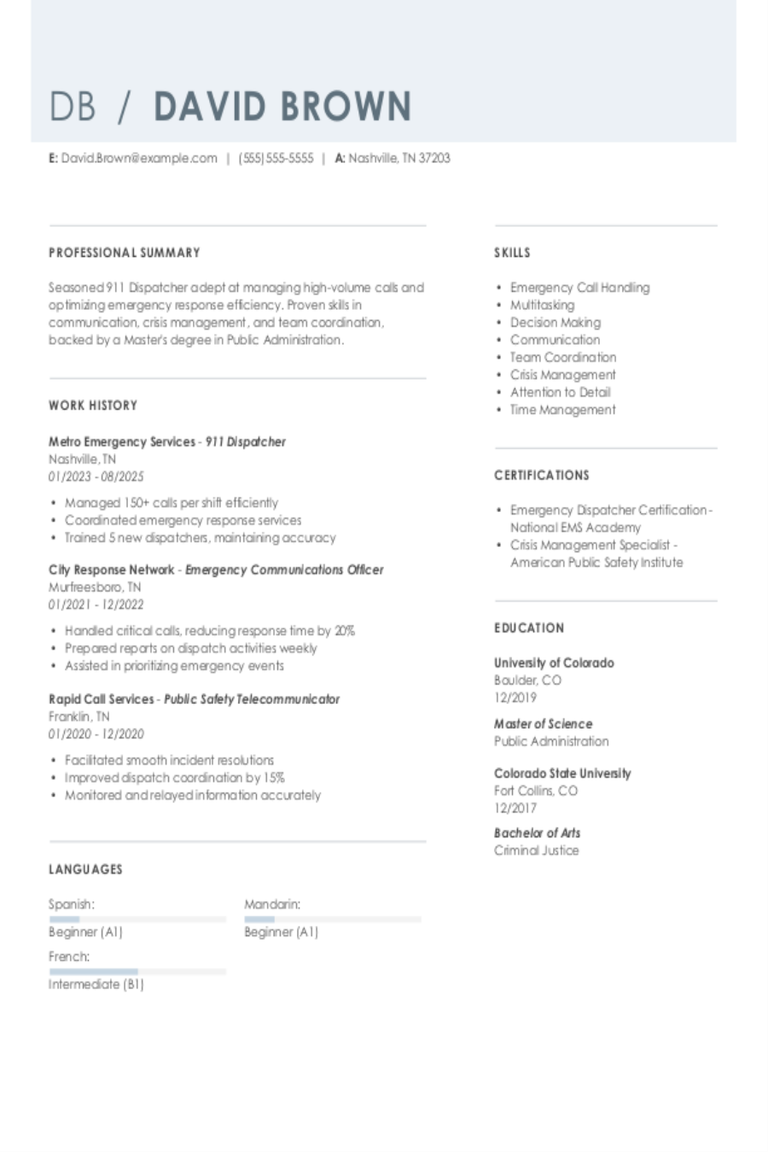
911 Dispatcher Resume Examples & Templates for 2025
Explore 911 dispatcher resume examples and tips to help you show your quick thinking, clear communication, and ability to stay cool under pressure.Build my resumeImport existing resumeCustomize this templateWhy this
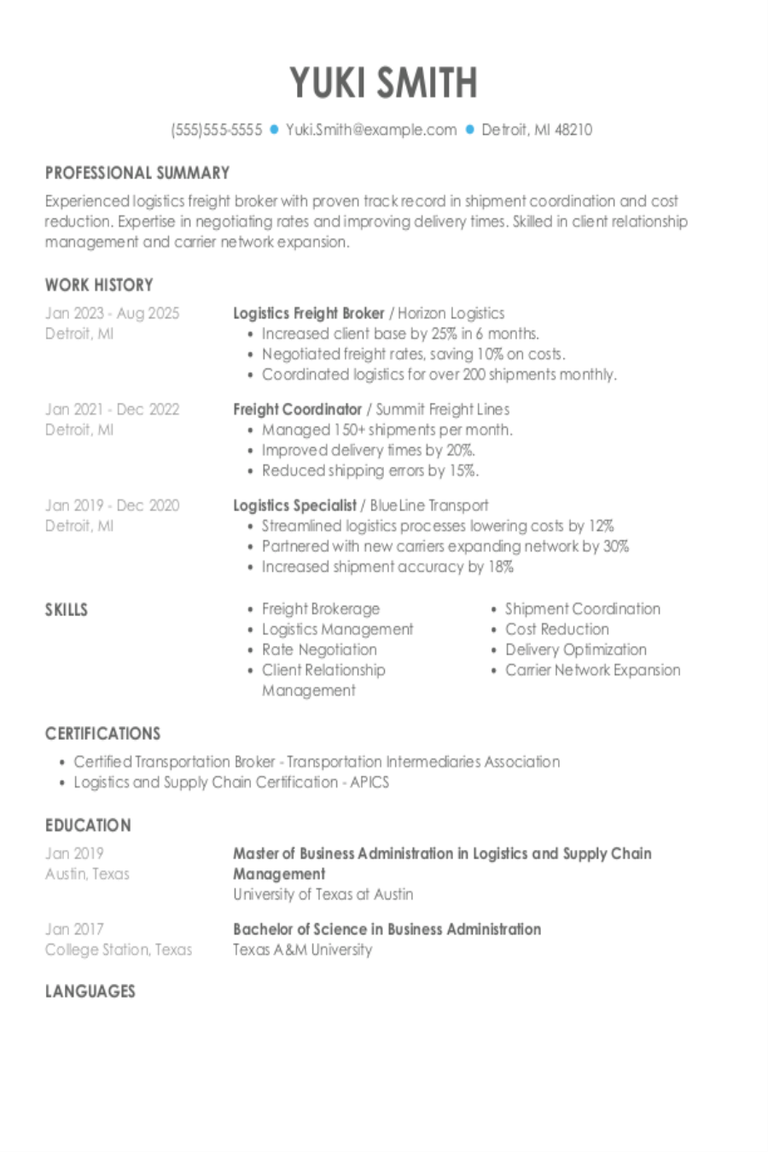
Logistics Freight Broker Resume Examples & Templates for 2025
As a logistics freight broker, your resume needs to show how you connect shippers and carriers, negotiate deals, and track shipments. Learn to highlight your skills in communication, problem-solving, and
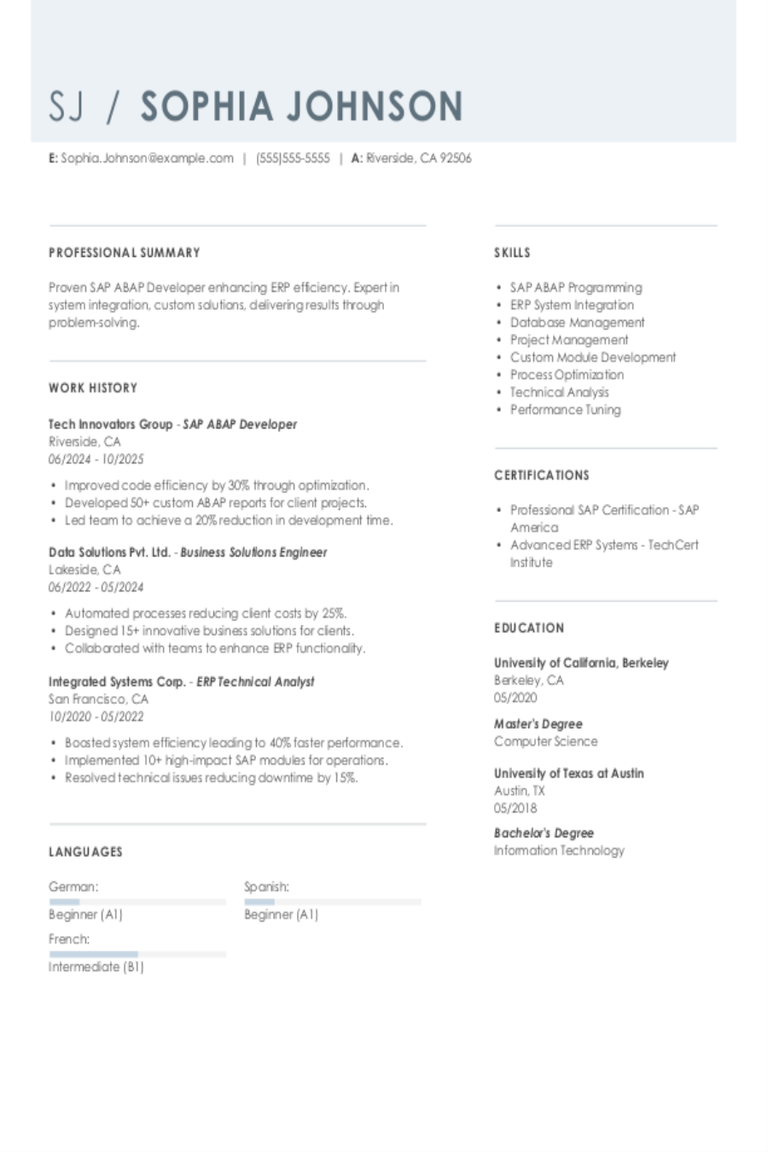
SAP ABAP Developer Resume Examples & Templates for 2025
Explore SAP ABAP developer resume examples and tips to learn how to spotlight your skills in coding, debugging, and system enhancements to stand out to hiring managers.Build my resumeImport existing
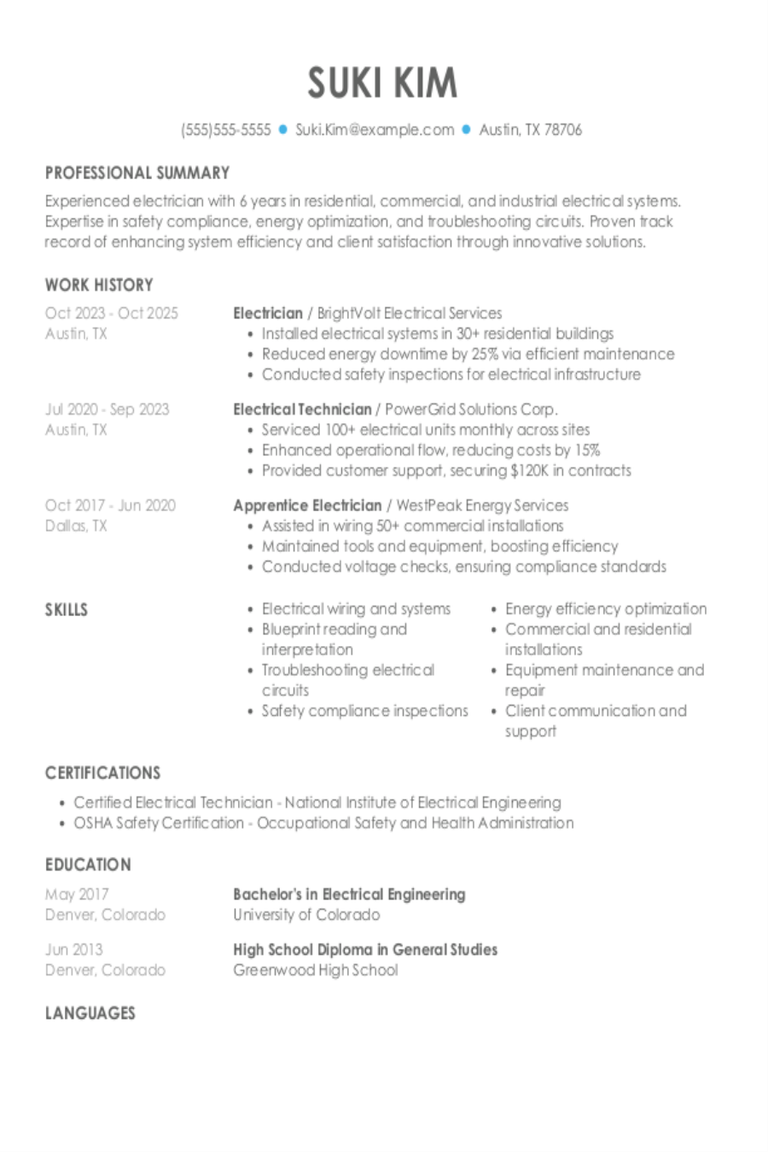
Electrician Resume Examples & Templates for 2025
Explore electrician resume examples to learn how to spotlight your wiring, troubleshooting, and safety skills. See how to emphasize your knowledge of electrical codes and highlight your experience across various
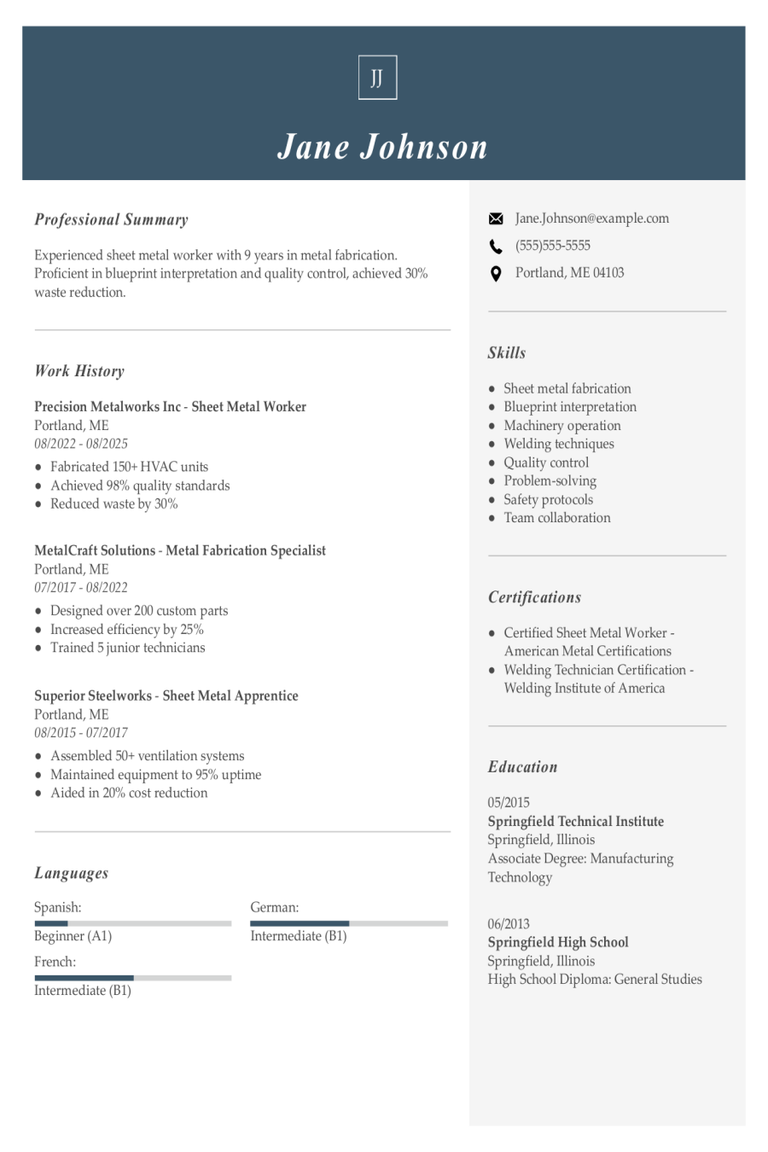
Sheet Metal Worker Resume Examples & Templates for 2025
Browse sheet metal worker resume examples and tips to learn how to highlight your hands-on experience and problem-solving abilities to stand out to recruiters and hiring managers.Build my resumeImport existing
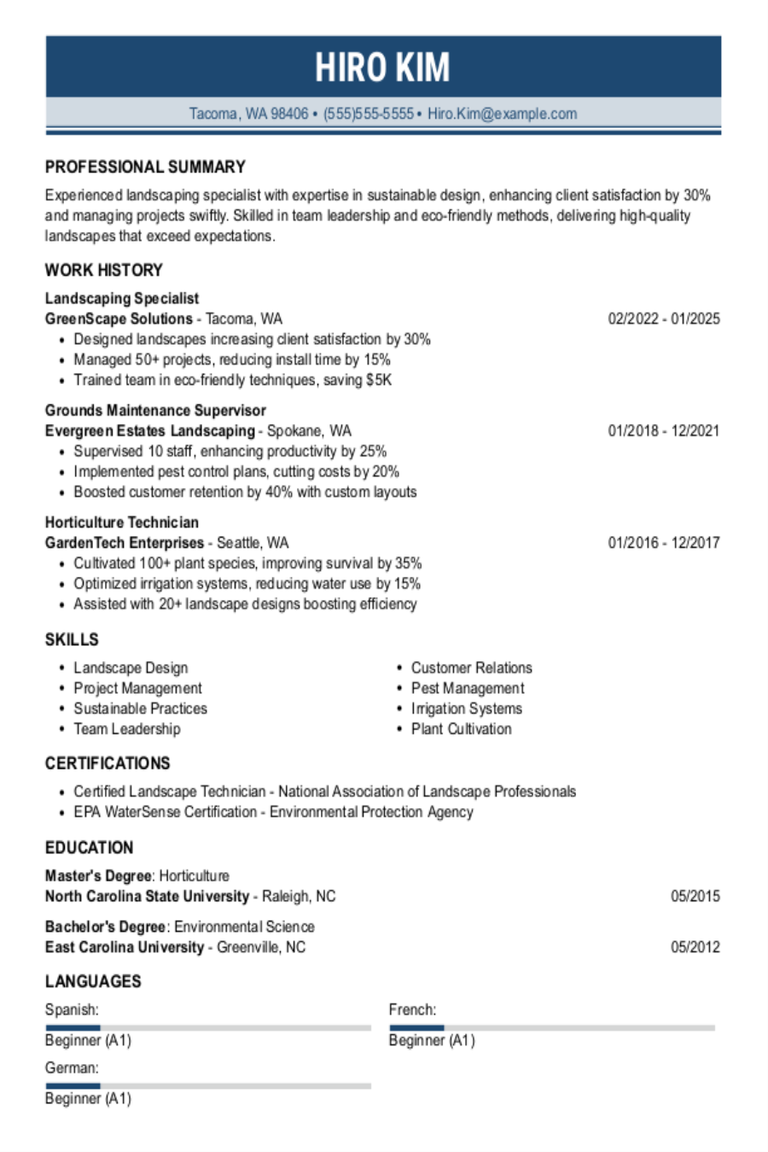
Landscaping Resume Examples & Templates for 2025
Explore landscaping resume examples to see how to showcase your gardening and design skills. Learn how to highlight your experience with plants, tools, and outdoor projects to catch the eye
